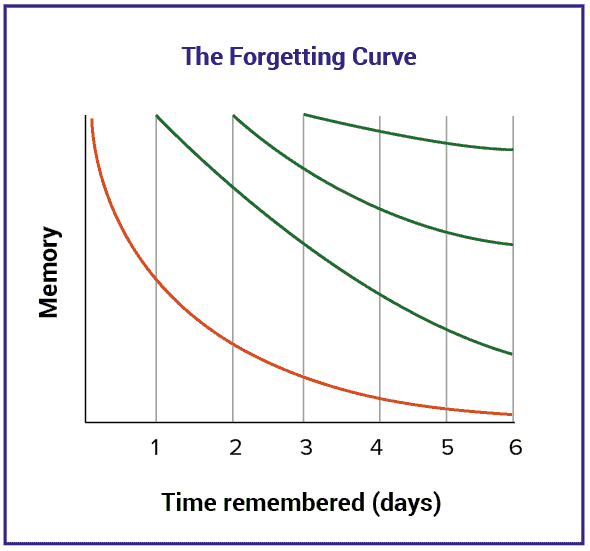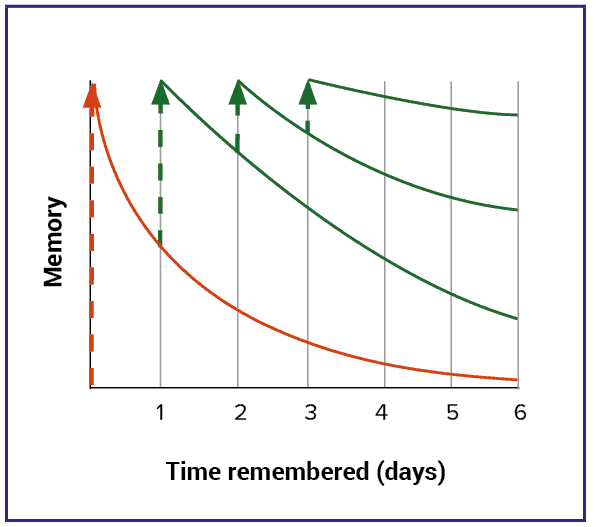Most people agree that to master a skill we need to practise. However, there are many ways to practise, some of which are more effective than others. Spaced practice or distributed practice is the idea that practising a particular skill or retrieving particular information is more effective when spread over time, rather than repeated several times in a single day or session.
The origins of spaced practice
In the late 1890s, the German experimental psychologist Herman Ebbinghaus reported the ‘spacing effect’. He was the first person to describe the forgetting curve, which shows how quickly memories fade after learning. Note the red graph: about 50% is lost after one day.

Image from Wikipedia
Practising or rehearsing over time with intervals in between slows down the forgetting process, making spaced practice much more effective than practice that is massed, or done all at once. Each green line on the graph represents a rehearsal or instance of spaced practice, where the memory goes back to 100% and then decays again: importantly, the memory decays in a more gradual manner after each spaced repetition.
Why does spacing work?
When memory is encoded and stored in the brain, connections between neurons are formed. Memories are represented by networks of interconnected neurons and, when we learn something new, a new network is formed. This process of biological consolidation of memories requires time. Research shows that resting (and, better yet, sleeping) after learning enhances our ability to remember the information. Spacing out the repetitions may allow the brain machinery to work without interference between the two events.
Another reason why spacing is effective is that, over time, memories decay and becomes less and less accessible. By attempting to relearn something after a period of time we are actually reconstructing the information itself, and, even more importantly, we are reconstructing the pathways that lead to it so that it will be more accessible next time. The reason spacing is effective is that it triggers active effortful reconstruction of the retrieval pathways: in other words, spacing induces more effective retrieval practice.
Another advantage for spaced learning is that the passage of time also changes the context of learning. If time has passed since our last practice, we will most likely approach the information in a different way, and use different cues or triggers. It is like learning several different routes to a house from different initial locations, which ultimately will allow us to get there easily, no matter where we start from. By practising in varied contexts, we are making sure the information will be much more accessible, in different situations and with different cues.
The bottom line is that practice should be effortful to be effective. We should concentrate on reconstructing pathways, not just revisiting the information. By spacing the repetitions we are making it harder on ourselves, but the effortful reconstruction process is what makes practice beneficial since we are building stronger pathways to the memory. Rest is also crucial to memory. Following the effort of reconstruction, it is better to rest in order to allow the pathways to consolidate. A second immediate repetition is not challenging enough and consequently not so effective. In addition, it may interfere with the consolidation processes of the previous attempt. To apply effective spaced practice we should work hard and then take a break.
How long should you wait between rehearsals?
The answer to this question depends on several factors, including the level of difficulty of the material, how familiar it is for the learner, and how much it has already been practised. It is most advantageous to rehearse when it has decayed significantly but not completely. We want reconstruction to be effortful but also effective. Take a look at the forgetting curve again below, the first rehearsal after one day should reconstruct about 50% of the learned information. After a few repetitions, the decay is slower, and hence larger spaces can be used.

Researchers have found a clear relationship between the spaces between revisiting the material and the time it will take to reach optimal performance[i].Short spacing times (seconds and minutes) produce short-term optimal performance, while longer spaces produce long-term optimal performance: in other words, the longer the spaces, the longer the learning is retained. Researchers have concluded that at least one day is required between repetitions to maximise long term retention (weeks and months), and that longer spaces (such as a month) can produce even longer-term effects.
Putting this information together, the conclusions are:
- Repeatedly rehearsing the material in the same study session will not have long-term effects and may even impair learning (cramming is not effective for the long term)
- Repeat the same material on subsequent days produces long-term results
- The more we practise, the more stable and accessible the information becomes, which means that it will ‘survive’ longer gaps, and subsequent repetitions will take less effort
How does it work in the classroom?
Everything that we learn should be practised effectively or it becomes unusable. Practice is obviously an important part of the teaching process, and to maximise its effect we should consider implementing a programme of strategically spaced retrieval. Once the information is acquired it should be revisited in increasing spaces, starting with days and weeks, and then spreading out to months and years. One barrier for learners is that frequent repetitions are easy to do, while repeating older material is much harder, and may feel extremely vague and even impossible to reconstruct. Understanding the benefits of spaced learning, teachers should take these challenges into consideration when planning teaching routines.
It is illuminating to compare spaced practice in the classroom to practice routines that are common in other fields. For example, when we practise music or sports, we often return to pieces of music we have mastered, or repeat older and more basic exercises on a routine basis. Even at the highest levels, musicians and athletes still practise basic skills. We should adopt the same thinking in regard to learning academic subjects at school.
How to incorporate spaced practice
Start bybuilding systematic reviews of previously learned information into your planning. Be specific about content and schedule some form of review in each lesson. Build spaced practice into classroom routines, and bear in mind that, while it may seem challenging at first, it becomes considerably quicker and easier in subsequent attempts. It is worthwhile to explicitly explain to students why they are doing it. In this blog post, a secondary school psychology teacher shares the simple method he devised to prove to his students that the method is working.
There are simple ways teachers can support the review process by adjusting it to where each student is in their learning. One practical example is to use the Leitner system for effective use of flash cards, explained in this 8-minute video about spaced practice. This method allows every student to focus each study session on the cards that need the most attention.
It is also important to differentiate the practice phase from the initial learning process. Initial learning is when a concept is presented, defined, explained and demonstrated. It is the building phase and it requires working memory resources to build the new information on the basis of prior knowledge. At this stage, it is helpful to reduce cognitive load by repeating the same points several times in the same lesson. The practice phase occurs after the new concept (or skill) is established, and is necessary to maintain what was built as well as to create and strengthen pathways to it. More challenging and effortful methods than are used during initial learning are appropriate during the practice phase.
The value of interleaved practice
Interleaving is another way to make the practice distributed, effortful and varied. It is an approach that involves mixing up the order of tasks rather than repeating the same kind of task over and over again. The benefits of interleaving are related to the those of both spaced and retrieval practice: mixing up the order of learning creates spaces and distractions between two repetitions of the same material, which forces students to re-engage with the material and invest effort in reconstructing the information. For example, rather than having students complete a set of addition problems followed by a set of subtraction problems and so on, it is more effective to interleave different kinds of arithmetic problems. This approach strengthens learning because it requires students to consciously select the most appropriate strategy for solving the problem rather than automatically using the same strategy they used for the previous problem in the group. You can read more about this in this short review with examples.
Recommended further reading
Brown, P. C., Roediger, H. L., & McDaniel, M. A. (2014). Make it stick. Harvard University Press.
Dunlosky, J. (2013). Strengthening the student toolbox: Study strategies to boost learning. American Educator, 37(3), 12-21. https://www.aft.org/sites/default/files/periodicals/dunlosky.pdf
Rohrer, D., Dedrick, R. F., Agarwal, P. K. (2017). Interleaved mathematics practice: Giving students a chance to learn what they need to know. http://pdf.retrievalpractice.org/InterleavingGuide.pdf
Team Tom Education (nd). Spiral, massed and spaced math practice. https://teamtomeducation.com/spiral-and-massed-math-practice/
The Learning Scientists (nd). Spaced practice. https://www.learningscientists.org/spaced-practice
The Learning Scientists (nd). Interleaving. https://www.learningscientists.org/interleaving
Endnotes
[i] Cepeda, N. J., Pashler, H., Vul, E., Wixted, J. T., & Rohrer, D. (2006). Distributed practice in verbal recall tasks: A review and quantitative synthesis. Psychological Bulletin, 132(3), 354.
By Dr Efrat Furst


